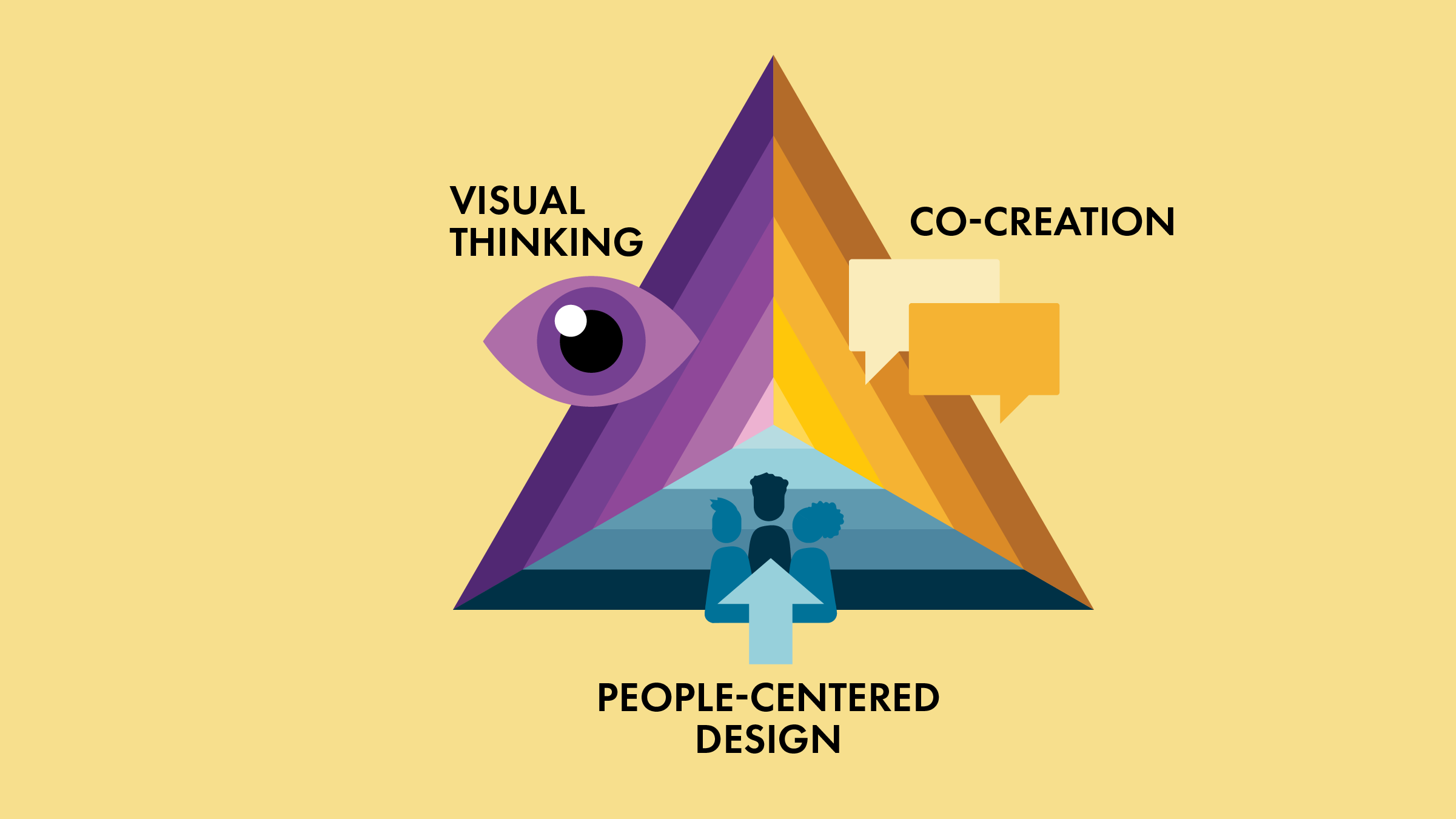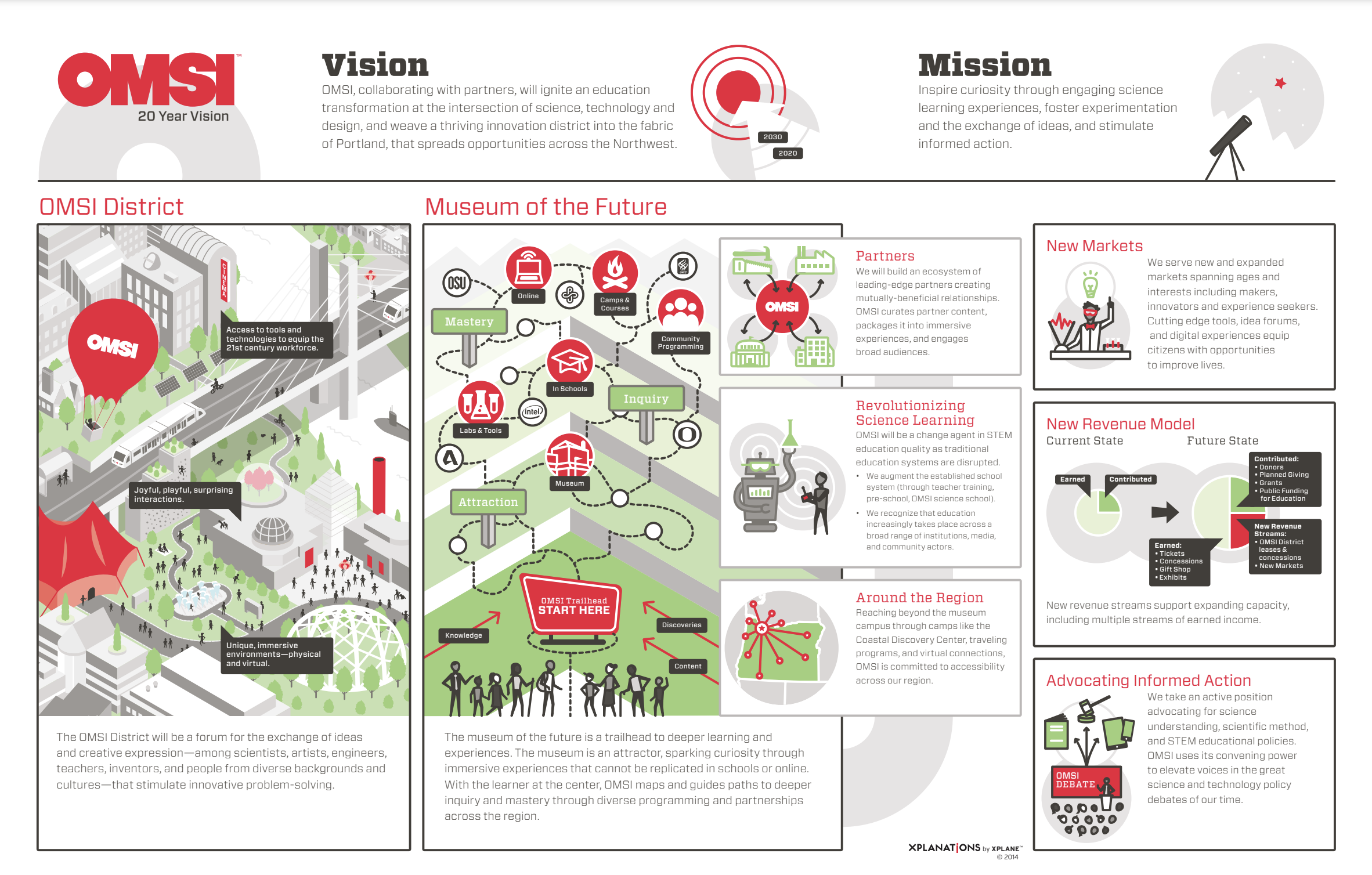Where do you start when you need to lead organizational change? As experts in the field of organizational transformation, XPLANE begins with people. Here’s how we work—and why our approach is so effective.
If you’re trying to lead change with a sizable group of people, you’re going to need to align, inspire, and mobilize a diverse set of stakeholders. Success will depend on your ability to connect deeply with your audience, understand what matters to them, and connect your vision and goals to their day-to-day ways of working.
At XPLANE, we focus on leading change through people, an approach that is the single most effective way to successfully move entire organizations through change to a new normal. Our processes are designed to quickly gain a deep understanding of your imperatives and context, incorporate diverse points of view, and design solutions to engage with and motivate change across your organization.
Here is how our approach can help you accelerate your transformation objectives.
The Three Principles of Organizational Change
The XPLANE approach is rooted in three principles: people-centered design, visual thinking, and co-creation.
Grounding our work in these principles enables us to rapidly understand our clients’ needs, work collaboratively with clients to develop meaningful solutions, and help clients communicate complex ideas in ways that are easy for people throughout the organization to understand.
We help clients achieve:
- Higher success rates of strategic initiatives and change efforts
- Faster adoption of new ideas, strategies, and initiatives
- Increased clarity and alignment toward a common vision
Let’s explore these three principles.
People-Centered Design Leads to Higher Organizational Change Success Rates
Organizations spend $160 billion a year on strategy efforts, but 80% of strategies fail.
Why is this?
While executives often have a line of sight from point A to point B, the rest of the organization can feel disconnected from the vision and unclear about how they fit in or contribute.
To solve this challenge, XPLANE roots our approach in people-centered design. We create solutions based in understanding the needs and desires of the people who will be affected by a particular effort or change. This involves conducting research, engaging with stakeholders, and above all, empathizing with the people who will need to adopt a new status quo.
By centering the design process around the people who will enact the vision or use the solution, we can ensure the end result is something that meets the needs of those who will benefit from it.
People-Centered Design in Action
Here’s an example. One of our clients, the Oregon Museum of Science and Industry (OMSI)—an award-winning science museum—was having trouble aligning on tough trade-off decisions and articulating their vision for the future. Executive leadership realized they needed an approach to strategic planning that felt authentic to their culture yet would support trade-offs in their consensus-driven organization.
To help them address this, we focused on two groups—those impacted by the approach and those developing the approach. We worked to help each group empathize with the other by exploring some questions. What were their concerns and biases? What were their expectations? How would achieving the museum’s vision impact them?
By centering our efforts around these groups, we made sure all voices were heard and the right gaps were addressed. This helped everyone see themselves as a successful part of the organization’s vision and strategies.
“The very exciting part of our process was inviting stakeholder input and feedback. This allowed us to hear from people who were deeply involved in the day-to-day of the organization, not just from tops down with all of our own biases and filters.”
- President and CEO of OMSI
Visual Thinking Creates Greater Clarity and Alignment
If leading an organization were as easy as steering a ship, a simple turn of the rudder would bring everyone along together. In reality, though, it takes a concerted effort to connect a group of people to a shared vision and align everyone on a common path.
At XPLANE, we leverage visual thinking—a methodology that uses tools to externalize internal thinking processes, making them more clear, explicit, and actionable—to achieve clarity and alignment in record time.
Visual thinking permeates our approach because our brains process verbal and visual information differently. Verbal language is processed in our frontal lobe and tends to be linear. Visual language, on the other hand, is processed in our visual cortex. It is multidimensional, allowing us to use multiple sensory inputs to generate meaning, including language.
In practice, when we say “visual thinking,” we mean using visual practices to get to the root of how to understand complex ideas in a way that’s easy to communicate. By “visual practices,” we don’t mean diagrams, charts, and tables—we mean pictures. We mean actually putting pen to paper with your hand and drawing, which allows people to use their visual cortex to externalize (complex) ideas and help make sense of them.
At XPLANE, we use visual thinking to help clients explore potential solutions to difficult problems. Visual thinking allows people to visualize an outcome or impact, freeing them from the need to define a solution in words when they still may be processing it—and allowing us to approach problems from a new angle.
Our team puts these elements into practice in both in-person and virtual environments, maximizing what can be achieved in a short period of time. In addition, our deliverables are highly engaging visuals that help clients connect and communicate in powerful ways on an ongoing basis.
Visual Thinking in Action
When our OMSI clients walked into their first XPLANE workshop, they were welcomed with a collection of visual artifacts displayed throughout the room. Visual representations of the agenda, a list of objectives, and other introductory information that we had drawn by hand on sheets of poster paper were tacked to the walls for everyone to easily see.
These posters were much more effective than a static PowerPoint slide: They offered information that was persistent, accessible, memorable, entertaining, and understood—and that set the tone for the hands-on work we did together throughout the workshop.
We carried this visual thinking approach through all of the tools we helped them build to share their new strategy and vision with their entire organization. The result was a 31% increase in their employees’ understanding of the organization-wide strategy.
"I am sold on the power of visual tools to communicate ideas. I use the maps we created with XPLANE to communicate the plan at least once a week—often more."
Design through Co-Creation Leads to Faster Adoption
As any leader knows, change takes longer than we want it to. It would be so simple if we could state a change, have people hear it and understand it, and get down to work. But the reality is most people need to hear it 100 times before they’ll believe it.
Is there a faster way?
Yes.
At XPLANE, we prioritize co-creation and involve our clients and their key partners in the development and design of change solutions. Why? People more rapidly adopt what they help author, speeding the way to understanding, buy-in, and commitment.
We view our role as partners with our clients. Rather than prescribe a “right” answer to a vexing issue, we facilitate a process where we design solutions together. This involves working in concert with clients and stakeholders to develop strategies and deliverables based on their own detailed knowledge of organizational dynamics.
Ultimately, the purpose of this work is to create a sense of ownership that leads to greater buy-in and support. By focusing on our clients rather than ourselves in this process, we leverage their expertise and insight to develop more effective solutions. As we like to say, “the smartest person in the room is the room itself.”
Co-Creation in Action
During the discovery phase of our strategy work with OMSI, we asked participants to show us what success looked like to them. They sketched, wrote, and diagrammed their individual visions and then shared their drawings with each other.
As we talked through each drawing with them, we took note of which parts of each concept resonated with the group. At the end of the workshop, we had a collection of visuals generated by the team that we used for the basis of a shared visual concept. This co-creative process continued in the design phase with feedback and insights that helped shape the visual design.
The Recipe for Success
In an environment that can pull people’s attention in many directions, where priorities can quickly shift and compete, and where ambiguity can stymie or slow progress, XPLANE cuts through the noise and engages the hearts and minds of diverse stakeholders.
Our unique approach—combining people-centered design, co-creation, and visual thinking—achieves powerful, lasting results and can set you on a course for rapid impact in enacting change, transforming your organization, and achieving ambitious strategies.
Along the way, we have fun and create meaningful experiences that leave clients better connected to their mission and to each other.

